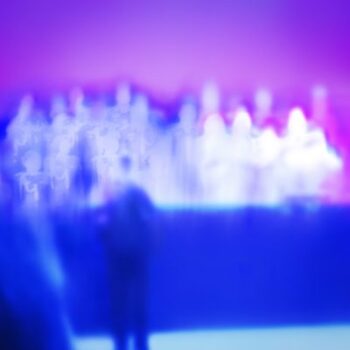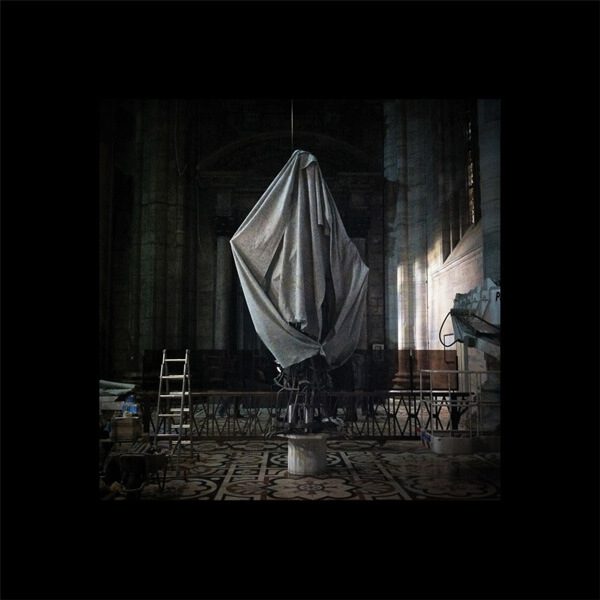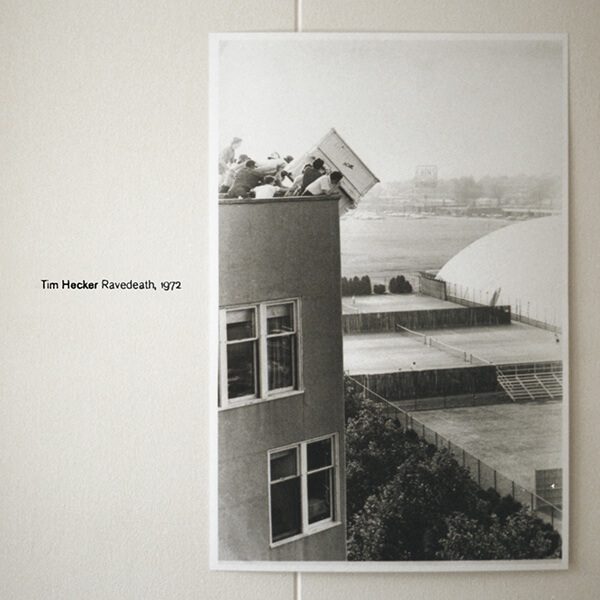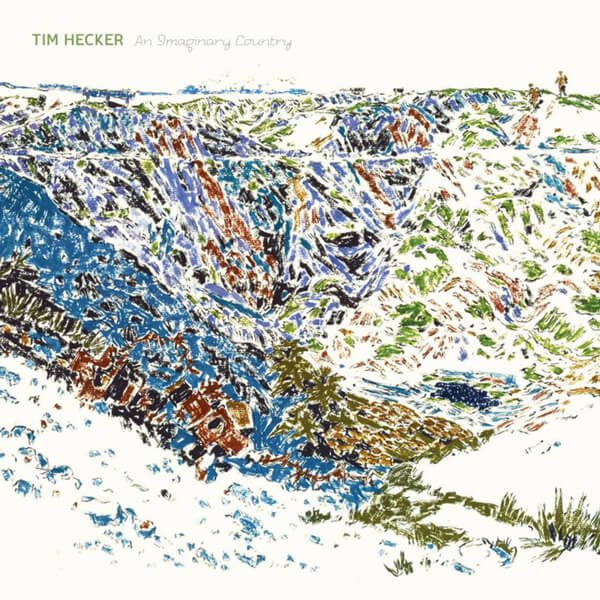
Tim Hecker has waged a stealth campaign against the banality of contemporary electronic music for some time now. After giving up a career in politics and finishing a PhD in his Canadian homeland, he recorded as a dance music deejay for a brief interval, under the name Jetone, until coming to find the aesthetics of the genre too confining. A turn in the direction of more abstract and ambitious melodies, patterns, and timbres, began in the first year of the new millennium with Haunt Me, and has continued since. Where some non-dance electronic music inevitably results in the quiet or decorative, Hecker’s march has been toward the more textured and dense, always inflected with noise, white noise, and sound material that would not be considered musical in the narrow range of popular music. Whereas some electronic music of this kind—Autechre, let’s say—has become aggressively synthetic and futuristic, Hecker has, especially on the most recent albums, incorporated analogue instrumentation and sampled Renaissance vocal music, with the result that the pieces, essentially electro-acoustic now, have become more like sound art or conceptual art or highly manipulated collage, than like the intelligent dance music that has come out of England. In short, Hecker is behaving like a composer, these days, and if there are no notes on the staff, or if the notes on the staves fall more often to collaborators, that should not diminish his stature as a first-rate thinker about how sound happens in the digital age and how this contemporary iteration of what music is contrasts with music past.
In fact, Hecker’s PhD dissertation (The Era of Megaphonics: On the Productivity of Loud Sound, 1880-1930) was on exactly this subject, on controversies and debates about noise, and about how noise in the 19th and 20th century was experienced occasionally as a desirable physical phenomenon. Here’s an excerpt from Hecker the writer:
In 1869, a very large musical celebration took place in Boston, Massachusetts. The National Peace Jubilee, as it was called, was a gathering of some 11,000 singers from some 100 choral groups with over a thousand-piece orchestra section. It was then proclaimed to be the “greatest musical enterprise of modern times.” If that wasn’t quite true, it was still one of the largest gatherings to showcase a distinct blend of celebratory patriotism and spiritual revelation. Spectacles such as the “anvil chorus,” which swung one hundred anvils in unison, reportedly “gave an impression of sublimity more than noise.” The massive, sprawling History of the National Peace Jubilee text referred to the crowd as solemn and oceanic.
Loves Streams, Hecker’s new album, will be released tomorrow on the venerable 4AD label, and as befits such a release, it already has a higher profile than the very strong prior recording (Virgins). As a remixer, and a producer, and an articulate voice on behalf of the theory of electronic music, Hecker is taking his place at the forefront of the medium with players like Daniel Lopatin (of Oneohtrix Point Never), who are reshaping what electronic music popularly is, and what role it plays in music-making now. Human voices shimmer distantly, in and out phase, on Love Streams, without ever being in the forefront of the mix, often confounding the prevailing rhythm of the pieces, so that rhythm becomes something much more complex and intuitive than in the popular song, in a way reminiscent of Steve Reich and middle-period minimalism. It’s a lovely, mysterious, moving, and challenging album. If it doesn’t ape the stylistic ideas of the film director whose title it borrows, it has some of the emotional or affective ambition of Cassavetes. “Love,” then is not to be taken lightly here. It is being engaged at full force, megaphonically.
This interview with Hecker was conducted in the lobby of a hotel on the Lower East Side of Manhattan at an ungodly hour, because I was on my way to teach in Minnesota. Hecker was plied with a common stimulant in order to function. The interview was in every way more enjoyable than Minnesota on February. And as befits Hecker’s style of cutting and collaging and retrofitting, I am including brief passages from his dissertation throughout.
***
The Rumpus: Are you playing gigs right now or are you mainly doing press?
Tim Hecker: I don’t have any gigs till April and I have one in New York. I’m doing maybe ten in the spring. But I kind of want to make it less of a live performance. Into my forties, I don’t want to be this desperate performance-based person. So I’m trying to find a way to make music work as a living. People used to make their living selling albums. Those days are over! It’s kind of an odd time. I guess it’s kind of like writing.
Rumpus: What’s good about the merchandising of books is that books have not successfully made the transition to digital. The thing they’re saying in the book business now is that the Kindle is flat or down in the last couple of years whereas physical books and indie book stores are up. People still want to buy books.
Hecker: Borders got rightfully slaughtered and every strip mall near Whole Foods in rural Florida went bankrupt but there’s still McNally-Jackson, which is thriving.
Rumpus: A lot of indies have sprung up in small towns and so on and they’re taking up the spot where the chain store used to be. It kind of works! There are still objects to sell. So did you make vinyl for this?
 Hecker: Yeah, well, a double vinyl.
Hecker: Yeah, well, a double vinyl.
Rumpus: I think the record is really magnificent.
Hecker: Thank you very much.
Rumpus: I liked the last one a lot, too, but I sort of want to explore what’s different about this from Virgins. How did you approach this recording with respect to what you’ve done in the past?
Hecker: I basically had this problem with bombast and intensity. And I started to feel like it was a nuclear arms race. You’re known for making evocative, strong work: what do you do down the line somewhere? What’s your move? I felt like my path was a path of nihilism, like if you want to make the next record more intense, how do you do that with digital mastering and limiting and clipping loudness, greater density, and just making it more porous or soupy? I felt like the way forward was stepping back and actually making something understated, something that’s not as bombastic and not as crescendo-driven and intense in quotation marks.
In the end, I tried to do something that was a bit sideways from there and approached the project with an idea of doing an aural birth of 15th century calm. People still talk about sampling as this new, progressive problem in music. There are technologies now where you can glean the polyphonic information out of a sample and then put that back in and then score it for five instruments. You don’t need digital audio to sample; you can rewrite things. So, I used that and kind of re-scored a few composers from the late 15th century like Josquin des Prez and wrote that MIDI information for a mid-nineties artificial intelligence.
I started the work with that kind of approach: just write things bright and clean. The new distortion but no distortion: super clean. I didn’t fully get out of the trap of distortion and intensity and bombast and bass. Additionally, I worked with the composer Johan Johansson, who wrote some choral arrangements for me. I took all this material back and over some intense months made some pieces and funneled it into what became the record.
Rumpus: Is the anti-bombast thing reactive away from stuff that’s happening in electronic music and dance music with the sort of peaks and valleys of dance floor stuff?
Hecker: It’s not so much dance as it is some personal thing. I don’t feel like music is getting more intense; I think generally the channel for deeper harmonic saturation is not just a sine wave—but a really crunched sine wave. You talked about dance: Skrillex uses this harmonically rich kind of sound. The trend in music is towards a harmonic saturation. I wouldn’t say I’m reacting against that. It’s just a personal choice to move into some weird space. This also allows me breathing room in the future. It just felt like the right thing to step back on.
Rumpus: So you started with the 15th century choral music? Sampling that and then monkeying with it?
Hecker: That’s the foundation of all the music, even on the instrumental pieces. It all comes from Josquin des Prez and a few other composers. Once you have MIDI information—I mean, it’s a bit technical—that’s your paint. You can slow down, pitch up, change notes within a different key. That’s the foundation in which you can write things.
“In discussing megaphonics it is important to delineate ‘sound intensity’ from ‘loudness.’ ‘Intensity’ is an objective, measurable reading of the power of acoustic phenomena whereas “loudness” is a subjective and internal experience of external acoustic phenomena. They do not always necessarily correspond: ‘Intensity’, notes Greg Milner, ‘is what makes our eardrums vibrate, but when those vibrations are translated into electrical impulses in the cochlea and sent to the brain, the magic of psychoacoustics takes over… intensity “is correlated with what happens outside our ears, but loudness exists only inside our heads.'” Loudness will generally mean to be the quality of a sound that is essentially a psychological correlate of physical sound intensity. It is a subjective term through and through. It suggests the perception of abundance.”
–The Era of Megaphonics: On the Productivity of Loud Sound, 1880-1930, p. 14
Rumpus: You make a bunch of tones and phrases and make the album around them?
Hecker: Exactly. So you have vignettes or sharp pieces of different things and then clean those, work on those, and, at that point I send some to Johan. He wrote three or four choral arrangements then we did a recording session where we used those arrangements; we also just had the singers improvise. I worked a lot with Ben Frost on this record, who is a friend of mine; I’ve done a lot of good stuff with him. He recorded those sessions. Ben Frost is a composer in his own right and he’s helped record my last three albums.
Rumpus: So Frost and Johansson wrote actual arrangements—notes on a staff arrangements—over existing sounds that you’re making?
 Hecker: I think I gave them the MIDI information; I can’t remember. Johan wrote a choral arrangement that was the score; we didn’t sync that up with original material but we had them play and listen to it. It’s a little bit DIY or punk in its approach; we don’t need things lining up, just keep incanting it until it becomes something else. At that point, it’s like a collage experiment: moving things together and cutting it, reforming it. It becomes like a late Picasso or something.
Hecker: I think I gave them the MIDI information; I can’t remember. Johan wrote a choral arrangement that was the score; we didn’t sync that up with original material but we had them play and listen to it. It’s a little bit DIY or punk in its approach; we don’t need things lining up, just keep incanting it until it becomes something else. At that point, it’s like a collage experiment: moving things together and cutting it, reforming it. It becomes like a late Picasso or something.
Rumpus: How much of the initial stages do you do at home?
Hecker: My own studio’s outside the house. I don’t really have the space in my own workplace to do recording sessions. I tend to go to Iceland, which I’ve done for the past three or four albums. It’s just this great place to work because you’re in this austere, beautiful country and you know why you’re there: you’re there to do this thing! It puts a bit of pressure on you and it’s the right thing. It seems kind of extravagant but it’s helped me a lot.
Rumpus: I have had the same reaction to that place. Is the studio in Reykjavik?
Hecker: Yeah, it’s just in the suburbs. It’s kind of outside the city, about a ten minute drive. To the north.
Rumpus: How did you start with Iceland?
Hecker: I went there the first time for Iceland Airwaves in 2009 or something, went to the studio and met people. I was invited by Ben Frost that time; we became friends and I think it was around 2010 when I came back to record Pipe Organ and did my first recording there. I’ve used that as a studio and a getaway since then.
Rumpus: Do you feel like the landscape has an effect on the work?
Hecker: I would say so; there’s a weird feeling from there. I would say it’s the environment and the smell of the sulfur that comes out of the taps.
Rumpus: (Laughs) That’s so funny—that sulfur. I remember it well. When you turn on the hot water!
Hecker: Just the baths and the swimming pools that are salt water treated, things like that. Their weird-ass candy and hot dog shops that sell candy and hot dogs! Things like that. I’ve done drives out of the city and have gone to glaciers and sulfur springs that are amazing but there’s been so many times I’ve gone airport-Reykjavik-alcohol-sleep-hangover-at-work, smell of sulfur, airport. I should do more of that, though.
Rumpus: They have the obsession with elves; do you know about that?
Hecker: Yes. They have the elf coordinator so if you want to move something you have to consult the oracle.
Rumpus: One time I went riding the Icelandic ponies there. They’re like the size of dogs! Anyway, we got on the ponies and we went two miles galloping into the wasteland out in the middle of nowhere. You can’t see anything in any direction except for—the little elf house just sitting there.
Hecker: A mini-house?
Rumpus: Yeah, a little elf house. They set them up in the middle of nowhere.
Hecker: Because they know there’s a spirit zone where there’s a stone. There’s a road and if you go straight, all of a sudden there’s this roundabout and then there’s a giant stone. There’s actually basement modifications where they bring in the elf people; sometimes they live down there.
“There are many possible sublimes of sound, but this thesis focuses on a cultural interest in the belief that technologies of loud sound propagation could create new means of navigation, new types of musical rapture, new states of anxiety, even new forms of mortal threat. This was an epoch that suffered through new blistering noises of aerial bombardments, mechanized warfare and amplified music. Blisteringly loud foghorns exhaled dire notes of nautical warning amidst the fog while pipe organs screeched attempts at musical transcendence. The sublime is referenced in different chapters in distinct ways to accommodate the subject under examination. For example, a form of musical transcendence from a pipe organ is different from the physical menace of gongs, artillery fire, or even foghorns. One is a moderately pleasant form of going beyond, the others invoke an acoustic index of threat or harm.”
–The Era of Megaphonics: On the Productivity of Loud Sound, 1880-1930, p. 37
Rumpus: All right, what about the title of the album? Love Streams?
Hecker: That came out of Cassavetes.
Rumpus: I heard you say in another interview that streaming was like music streaming but I wanted to know about the Cassavetes.
Hecker: I initially titled it Miasmas Dreams and was like “nah…” My friend pointed me to one of the late, less-loved Cassavetes films. It felt better, maybe poetic. I take the literary or textual aspect really seriously and I really enjoy writing weird album titles. I did a PhD; I enjoy writing.
Hecker: Media History.
Rumpus: In Montreal?
Hecker: Yeah.
Rumpus: Did you write your dissertation?
Hecker: I wrote a dissertation on the world’s loudest instruments and the history of loud sound in the late 19th, early 20th century. There are all these books on noise abatement, like rationalization in the public sphere and people making New York City quieter and this bureaucratic mindset. What about obsessions with subtle force? So I started to use that as my beginning and I did a counter history of people obsessed with sound so I looked at pipe organ builders who were this rogue group of people who were at the forefront of a new secular organ building after its religious basis was set free through Rockefeller grants and things like that. They funded 8,000 pipe organs across the states.
Those people believed louder, bigger, and earth-shaking would give you a new feeling that could be God but could also be something else. So I wrote a chapter on pipe organs and one on fog horns and about nautical signaling and how the eyes couldn’t work with light and we were forced into this precarious trust in sound and sound kept letting us down and the ships would still crash so they were learning about why loud sound doesn’t travel in a linear fashion. And things like that.
“As organs had the ability to span massive distances in displays of awe-inspiring power, they were also believed to have the ability to coalesce ethereal vibrations into material edifice. The idea of building a sound palace out of music was a common theme to many writers: the vision of a palace built out of organ music in Paradise Lost; Keats’ Lamia; andthe dome built ‘in the air’ of ‘music loud and long’ in Kubla Khan. It is almost an inversion of Schelling’s comment about architecture as ‘frozen music’; rather organs were seen as a form of liquid architecture. Perhaps most interesting is the work of Georg Joseph Vogler, a late eighteenth- century composer, organist, and writer who was known for a particularly odd approach to the organ. He was a traveling virtuoso and organ tinkerer who developed a style of popular organ performance akin to ‘pictorial improvisations’ which lured audiences from across Europe. Robert Browning made reference to Vogler as another emblem of sonic palace building, a practitioner of music who made sound capable of carving out etheric solids: ‘Would that the structure brave, the manifold music I build; Bidding my organ obey, calling its keys to their work; Claiming each slave of the sound, at a touch, as when Solomon willed; Armies of angels that soar, legions of demons that lurk…’ Organ music was repeatedly seen as aspiring towards a state of material edifice. As I will argue, organs began to merge with the buildings that hosted them in attempts to turn architectural structure into resonant instruments.”
–The Era of Megaphonics: On the Productivity of Loud Sound, 1880-1930, p. 52.
My last chapter was on the end of life by sonic force so I looked at Ernst Mach and psychophysics and how a lot of those ideas sent shockwaves and are seen as physically real, material force. It seemed to even be able to lead towards death.
Rumpus: When I was in my twenties, I worked—for a very short period of time—for La Monte Young, who is a hero of mine. He sort of worked along those lines.
Hecker: He’s still going, right?
Rumpus: He’s very old. I think he’s in his early eighties.
Hecker: I haven’t been to Dream House. Is it set up now?
 Rumpus: They relocated it. The early La Monte pieces, you probably know all this, were for the overtone sequences, and they were really loud. Even at the time I worked with La Monte just for that brief period, I noted that he had hearing aids, presumably from having the pieces turned up so loud. His work had a physical effect on the audience; that was the point of it. My guess is he lost a lot of hearing as a result. But it was the same thing: he wanted to feel it!
Rumpus: They relocated it. The early La Monte pieces, you probably know all this, were for the overtone sequences, and they were really loud. Even at the time I worked with La Monte just for that brief period, I noted that he had hearing aids, presumably from having the pieces turned up so loud. His work had a physical effect on the audience; that was the point of it. My guess is he lost a lot of hearing as a result. But it was the same thing: he wanted to feel it!
Hecker: When you have that ringing the next day, you did something wrong! I guess if you do that every day, you have systemic hearing loss. It’s a problem, for sure.
Rumpus: The recoiling from bombast is a growing away from some of the thematic material of your dissertation?
Hecker: That’s a good question. I found all my reading and writing informed my music in subtle ways. Ravedeath came out of studying the pipe organ, going to New Jersey—the world’s loudest and biggest pipe organ…
Rumpus: It’s in New Jersey?
Hecker: Yeah, Lenox City Convention Hall. It’s literally the musical technological equivalent of the Eiffel Tower in terms of engineering marvel. It should be a national treasure and I’m Canadian. It should be maintained; it’s falling apart. It’s abysmal and shocking! Thirty-three thousand pipes in what was the world’s largest convention hall—it’s a massive building—are embedded in the walls in, like, iron grates. There are jet engines in the basement feeding air. It’s insane! And it’s falling apart. I wonder about that: You can’t convey loudness in a recording inthe same way you can in a live performance.
Rumpus: And everybody’s mastering louder now so there’s nowhere to go.
“Fog signals are more than simply a beacon for wayward sea travellers. They also represent a sort of guardian against the void, or rather a type of acoustical index which demarcates multiple voids— the borderland between governed land and the ungovernable infinitude of the sea, as well as the void of visuality in which sight no longer provides any answers. Left with no other option for the helpless mariner, it was only the blunt force of cultivated acoustic power that could blanket the coastlines of North America with an aura of nautical safety.”
–The Era of Megaphonics: On the Productivity of Loud Sound, 1880-1930, p. 104.
Hecker: So what do you do with that? You need something else. I think it’s the equivalent of a painter making his great painting series, like something white rather than hyper color.
Rumpus: So did you actually master it lower?
Hecker: Yeah. I used a very good mastering engineer, Mandy Parnell. Let’s be gentle with the compression, let’s literally allow dynamic range to still sing means that it’s quieter compared to other records. It’s quieter than my past records and that’s a bit alarming.
Rumpus: It only makes a difference, though, in an era of streaming, right? Because it’s going to play lower than whatever the next song is.
Hecker: There’s something called Soundcheck now which actually normalizes. Justin Bieber which is shockingly dense and insane actually gets turned down so the organic bluegrass can actually sit next to it when it’s played in continuity. If you master your shit with that Bieber level of intensity, you suffer. It’s your loss. I read a bit about it and mastering engineers were like “This is a Godsend. This is over; we’ve found a sane path forward for the normalization of different music through the streaming device, through playback, whatever.”
Rumpus: Spotify won’t even register that a recording is mastered high.
Hecker: I don’t know what Spotify uses but I believe it’s going toward the norm so you can use a lighter touch on mastering and not be so scared.
Rumpus: So would Love Streams indicate a trajectory in the direction of—
Hecker: Lighter stuff? No! I really hold back; it’s my natural instinct to feel things. It’s relatively new (it’s been a little part of other records). It’s still not like New Age celestial harmonies kind of vibe. It still has a lot of disfigurement, a lot of rounded, slammed things, but they’re in comparison to things that breathe.
Rumpus: Is minimalism a touchstone for you? Eno styled minimalism? Or William Basinski?
Hecker: It depends on what kind of minimalism you’re talking about, of course. I love both those artists. I would say my minimalism references are early American minimalists from the 70s.
Rumpus: Like Terry Riley.
Hecker: You talked about early performances of La Monte Young, a lot of Philip Glass, early Riley. Really loud and raucous.
Rumpus: Glass was super loud, right?
Hecker: I enjoyed reading about his early organ quartets or phase pieces that were quite loud. That was one of my ideas five or ten years ago: that level of repetition and intensity and distortion was like a fabric that needed to be weaved more or explored further.
Rumpus: Did you see or hear any of the refabricated Metal Machine Music concerts?
Hecker: No.
Rumpus: They did one at Columbia University that was the loudest thing I’ve ever heard! Actually, the loudest thing I ever heard was Glenn Branca’s Symphony No. 3. I knew a guy at the venue and he let me go up to the sound booth. It felt safer in the sound booth; it actually felt dangerous down in the concert space.
Hecker: That’s great.
Rumpus: With Metal Machine Music, they give out earplugs to everybody. There was a big vat of them going in! It was at Columbia University School of the Arts. A genteel classical music venue, with earplugs. This was a string ensemble, you know! It was incredible. I took them out at one point because I just wanted to see what I missed.
“In 1923, a massive detonation was set ablaze in Germany releasing 1000 kilograms of explosives. It was not an accident. Nor was it an act of war or research related to the science of explosions. Rather, it was triggered with the singular purpose of substantial long-distance sound propagation. Its effect was substantial—detected at a distance of 700 kilometers away, it was by far a record for the longest documented sound propagation event. The Jütebog explosion, as it was called, was an example of the extent of sound dissemination so profound that it makes the alleged 100-kilometer capability of the ancient Horn of Themestius seem absolutely quaint.The 1923 explosion was one of many such tests. A series of explosions during the 1920s in Europe were not only a chance to assemble unheard-of amounts explosives together, but it was also the opportunity to test the thresholds of shock wave audibility across the span of countries rather than traditional challenges of propagation across valleys or regions. The late-nineteenth and early-twentieth centuries were the backdrop for a bounty of experimentation and scientific knowledge gathering around the question of the shock wave and the power of sonics. It is yet another example of the cultural obsession around the productive uses of loudness.”
–The Era of Megaphonics: On the Productivity of Loud Sound, 1880-1930, p. 155.
Hecker: I just read an old Kim Gordon piece in Artforum about Glenn Branca, from the 80s. It was pretty interesting. I definitely love his work but it’s making me want to revisit it.
Rumpus: The earlier ones are the better ones, I think. But they’re great.
Hecker: He wrote a crotchety kind of old man piece recently—I can’t remember what is was—but it felt like an old man shaking his fist at the world. He was going on about mp3s with just a “shit’s going downhill” kind of vibe. I’d rather think about The Ascension or something like that.
Rumpus: (Laughs) The Ascension is really magnificent. So when you think about minimalism, you think about melodically minimalist as opposed to quietly ambient minimalism?
Hecker: Absolutely. For me it’s the hypnotic simplistic reduction of hooks into some form of prayer wheel or something. I really appreciate people who can work in those quiet environments making really precious latticework like lace in a weaving but, for me, I like it a bit more hairy and like psychedelic Peruvian knits or something! You know what I mean? I go into fabric analogies, you know.
Rumpus: I guess I have one last question and that’s about how rhythms work for you. It’s all polyrhythmic as far as I can tell. In general, I really hate EDM. Part of the reason it makes me want to die is that I feel like the way rhythm works—with Skrillex, let’s say—is corporate. The four-on-the-floor thing is so like capitalism making you want to buy more.
Hecker: We should do an Adorno reading on Skrillex and vodka sales in Vegas. It’s definitely interesting. What’s interesting in that music for me is the harmonic density in some crazy melodic line that sounds like some Michael Bay film eating itself. Which I enjoy in the same way I’ll watch a cracked up Hollywood movie. Yet rhythmically, I guess that music just funnels more into predictable cash outcomes.
 Rumpus: A polyrhythm to me is the ultimate revolution because it resists taking Molly and standing on the dance floor like a zombie. It doesn’t allow the kind of rhythmic simplicity that caters to that diminishing pollutant.
Rumpus: A polyrhythm to me is the ultimate revolution because it resists taking Molly and standing on the dance floor like a zombie. It doesn’t allow the kind of rhythmic simplicity that caters to that diminishing pollutant.
Hecker: I like to make music for the person that goes to a rave like that on Molly and a piece comes on that feels like it’s falling off the tracks and it gets them ecstatic because that’s what I remember feeling like going to raves. I was just like “Why is this not more fucked?” I was dreaming of another world like the drug-induced “dancescape.” I did dance music for a short period of time but I felt like the fruit for me was in the outer dance world so I stopped doing overt techno and I think, in terms of rhythm, I enjoy things that feel like they’re falling off, like they’re just barely holding on.
That’s a real challenge today with ways of writing music and the software, the main, dominant forms. It really forces you into a grid. You can have different grids that have different syncopations or whatever but that metric still pulls you back in. Turning things off is difficult so you have to find different ways to work. Shit doesn’t line up perfectly and I like to work a bit crazy by design.
Rumpus: It’s like collaging, right? If you have different samples that have different rhythmical fields in them and you overlay them then you’re automatically going to get stuff that’s outside of the pulse.
Hecker: You just have to reject those platforms or find other ways to work that allow you that freedom. For me, it meant not using that software. I had to use something else. Offness yields a hypnotic effect. The brain can see simplistic patterns that lock and it’s boring after a while. I don’t cater to that.
Rumpus: They say that little kids don’t learn about the tyranny of common time until age three or something and, before that, they naturally count polyrhythms. I tried it with my daughter a little bit; I would teach her 7s and 11s and she would get that pattern because the toddlers are just pattern recognition machines! It’s so depressing to me that we give up our capability with respect to more complex musical languages.
Hecker: I come at it in a different way, in other ways of counting. It’s the same thing; it’s just a different way of working. It’s something to really fight against and important to support non-linearity or more complicated forms of repetition or static forms of time counting. No doubt about it.
Rumpus: I like how both this album and Virgins act as complete album-length pieces of music, too, because it helps with the battle against pre-digested sugary pop morsels.
Hecker: I’ll always probably do that and it’s probably more prevalent where the album is a denigrated form. I can’t get away from thinking about something that’s a forty-minute work. I still think about three-minute sections of intensity; I also like when they repeat or come back, like some kind of Amnesiac return, like that album probably has four motifs although it’s four tracks.
Rumpus: Was it a hassle making the LP version? Do you have to make decisions where to divide the work?
Hecker: Yeah, you start to think, when you’re finishing a record, in twelve- to fourteen-minute chunks. At a certain point, you do write to the format. It’s not a coincidence that most albums are between thirty-five and fifty minutes. It’s kind of like the 98-minute film. It becomes some paradigm for human attention in the media.
***
Photograph of Tim Hecker © Todd Cole.





